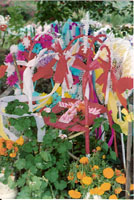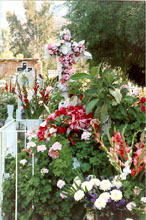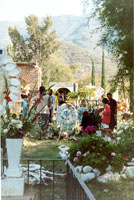The recent demise of one of my dearest friends has made me reflect on how my experiences in Mexico have not only enriched my life, but also taught me to better cope with death. I am deeply grateful to my Mexican friends for having given me a model for accepting human mortality and facing loss in a simple, straightforward manner.

Anyone who’s studied up on Mexico is probably aware of the country’s colorful Day of the Dead traditions. Guide books touching on the subject may leave the impression that once the November 2 celebrations end, a Mexican cemetery reverts to being a drab, desolate place. Not so. Family bonds transcend the grave and visiting the eternal resting place of departed relatives is just another of the quotidian activities tightly woven into the fabric of village life.
Ajijic’s cemetery lies just a couple of minutes from my home by foot. Odd as it may sound, I often include a stroll through the campo santo on the route of an early morning walk. Chances are that I’ll cross paths with someone I know: the seamstress bringing flowers to her departed spouse on their day of the wedding anniversary, the taxi driver come to remember his father’s birthday, neighborhood children helping refurbish the grave of a lost sibling, pulling weeds and refreshing plants with water drawn in an old tin can from one of several communal cisterns.
The graveyard is abundantly adorned with lush bouganvilleas, poinsettias, rose bushes, daisies, chrysanthemums and marigolds, along with sundry native trees and tall, stately cypresses. I suspect it is the cemetery’s uncanny resemblance to a botanical garden which makes it seem such a curiously cheerful place. While green things tend to flourish year-round in Ajijic’s benign semi-tropical climate, they also require constant care. Tending to plantings at the family plot and bringing freshly cut blossoms from the garden at home are among the motives that regularly bring people to the panteón.
 Wander through the cemetery any day at any hour, and it’s unlikely you’d find yourself alone there. The reasons for the steady traffic of visitors are myriad. For one, families customarily go to pay their respects on each anniversary of a loved one’s passing, taking along fresh flowers and prayers. Towards the end of October the panteón bustles with activity as villagers spruce up graves in preparation for Day of the Dead festivities. Even those who do not visit the cemetery regularly can be expected to turn up November 1 and 2 to honor their dead.
Wander through the cemetery any day at any hour, and it’s unlikely you’d find yourself alone there. The reasons for the steady traffic of visitors are myriad. For one, families customarily go to pay their respects on each anniversary of a loved one’s passing, taking along fresh flowers and prayers. Towards the end of October the panteón bustles with activity as villagers spruce up graves in preparation for Day of the Dead festivities. Even those who do not visit the cemetery regularly can be expected to turn up November 1 and 2 to honor their dead.
Another occasion that brings a multitude of visitors and surprising festivity to the local cemetery is May 10, Mother’s Day. The noisy explosion of dozens of rockets announces the celebration of a sunrise memorial mass in the graveyard. At its conclusion, a mariachi band bursts into a rousing rendition of the traditional Las Mañanitas. Throughout the day villagers arrive carrying huge bouquets of red and white gladiolas, carnations, roses and other fresh blossoms to adorn the graves of departed mothers and grandmothers.
 Naturally, villagers often gather at the campo santo to take part in a burial ceremony. I know such an event is about to happen when I hear the church bells peal slow and mournful clamores. After the funeral mass, the casket is transported from the church to the cemetery set at the edge of the village, a procession of mourners following on foot along the narrow cobblestone streets. Relatives and close friends of the deceased take an active role in the burial, helping dig the grave, lowering the coffin to its resting place, cementing bricks to make a crude vault, and shoveling the heaped up earth back over the tomb.
Naturally, villagers often gather at the campo santo to take part in a burial ceremony. I know such an event is about to happen when I hear the church bells peal slow and mournful clamores. After the funeral mass, the casket is transported from the church to the cemetery set at the edge of the village, a procession of mourners following on foot along the narrow cobblestone streets. Relatives and close friends of the deceased take an active role in the burial, helping dig the grave, lowering the coffin to its resting place, cementing bricks to make a crude vault, and shoveling the heaped up earth back over the tomb.
One thing you won’t find in most Mexican village cemeteries is discrete uniformity. No fields of dreary bronze plaques, no tombstones laid out row upon tidy row, no Astroturf. Here the graves are scattered about at random, a three-dimensional crazy quilt blanketing a sacred stretch of countryside.
Each plot is unique, often the result of a do-it-yourself effort reflecting the special talents of the departed’s relatives. A carpenter will mark a loved one’s grave with a simple wooden cross. A construction worker will form one out of cement, perhaps adding decorative touches with colorful handmade tiles left over from some building project. A master mason may fashion a more elaborate monument, say a conch-shaped niche graced with a statue of the Virgin Mary. If there’s an iron monger in the family, the plot may be surrounded by a low wrought iron fence. Affluent merchants and professionals are inclined to install more sophisticated monuments purchased in nearby Guadalajara.
Lost but not forgotten, each departed soul is cherished in a special way, still included in important celebrations and the day to day lives of Mexican families. Thanks to their example, whenever I step through the gates of the campo santo I now feel perfectly at ease, whether I’ve come to attend the burial of a respected friend or to visit the graves of my own loved ones, taking a moment to tend to the flowers. . . and remember.
